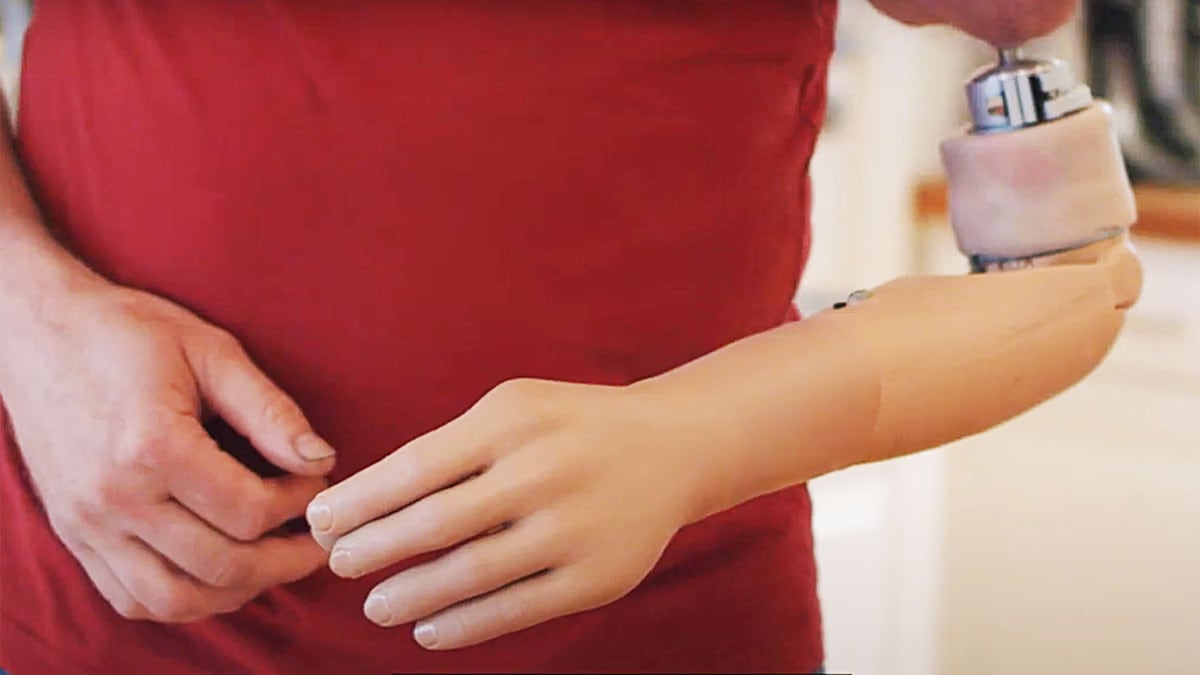The latest artificial hand purportedly responds to thoughts, creates the impression of feeling, and anchors directly the wearer’s bones. The e-OPRA might not be flesh and bone, but it’s apparently getting closer. And that could be good news for amputees.
The e-OPRA, developed by Swedish firm Integrum, reportedly combines several major advancements in prosthesis technology to produce a replacement hand that the company claims is more comfortable, more precise, and easier to control than old-style artificial limbs.
E-OPRA connects to the wearer via a special screw that anchors inside the bone. Electrodes connect the wearer’s brain directly to a tiny computer inside the prosthesis that translates neural impulses into commands. Think “pinch” and the robotic fingers will pinch. Sensors in the hand register contact with objects and feed it back into the wearer’s brain so that the artificial touch feels real.
Integrum tested the new artificial hand on four amputees starting in 2013. One of the test subjects was a man in his late forties whom the researchers have identified only by his first name, Magnus.
Magnus lost his right arm above the elbow in the early 2000s. He volunteered to try out Integrum’s prostheses as early as 2014, initially wearing a cruder version of the company robotic hand featuring a less sophisticated neural interface. The prostheses received and sent signals via stick-on electrodes instead of being wired directly to Magnus’ brain.
That made it less precise than later models would be. Still, Magnus with his restored ability to grasp and feel small objects was able to resume his old career as a truck driver.
The e-OPRA with its direct hand-to-brain connection represented an even bigger improvement for Magnus and the other test subjects, according to a team of researchers led by Max Ortiz Catalan, a bioengineer at Sweden’s Chalmers University of Technology who is also an Integrum consultant.
“All patients reported having greater trust in their prosthesis since the intervention, referred to it as being part of themselves, and reported positive effects on their self-esteem, self-image and social relations,” Ortiz Catalan’s team wrote in a paper that appeared in The New England Journal of Medicine on Thursday.
“Thanks to his new robotic arm, Magnus has been able to cope with all the situations he faces in his physically demanding job driving trailers in between Sweden, Norway and Finland,” Integrum claimed on its website.
E-OPRA advances many of the major aspects of prosthesis technology. For many decades, artificial limbs connected to their wearers by way of sockets and straps. In the 1990s, new “osteointegrated” fixtures—in essence, screws made of materials that encourage bone to grow around them—allowed many amputees to swap sockets for less awkward fittings.
A few years later in the early 2000s, scientists developed lightweight robotic limbs that could sense objects and push back against their wearers, roughly duplicating the push and pull of a flesh-and-blood limb.
Next came the electrode-based neural interfaces. Thanks to the same advancements that allow researchers to control drones with their thoughts, the next generation of prostheses took commands from, and fed sensation back to, the wearer’s own brain via patch-like electrodes that sensed electrical activity in the nerves.
E-OPRA combines and improves on all of those separate efforts, according to Integrum. Its fixture is even more compatible with bone, according to Integrum. Its sensors are more sensitive, the company claims. It ditches the external electrodes in favor of surgically implanted electrodes that connect directly to nerve endings.
The new prosthesis represents “an intimate union between the body and the machine; between biology and mechatronics,” Ortiz Catalan’s team wrote.
As a bonus, Integrum claims the e-OPRA doesn’t require special training. Just stick it on and start grabbing.
There’s lots of room for improvement in prosthesis technology, of course. For all its advancements in recent years, osteointegration still amounts to screwing metal into bone. The fixture juts through the wearer’s skin like an intentional wound. “Long-term success might be jeopardized by implant-associated infection,” according to one 2017 study.
And brain-to-prosthesis interfaces still have lots of room to improve. Scientists are still trying to decode which neural impulses correspond with which fine muscle movements. As a result, a robotic hand still can’t match a real human hand, researchers pointed out in a March paper. “The number of independent movements is still limited.”
But “limited” movements are better than no movements. A few decades ago, an amputation might end someone’s career or otherwise permanently impact their quality of life. It’s possible to imagine a time, not too far in the future, when losing a limb is just a temporary setback.






